Nude swimming
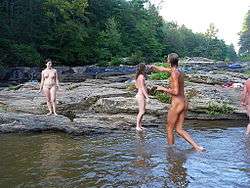
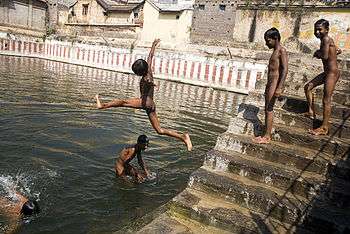
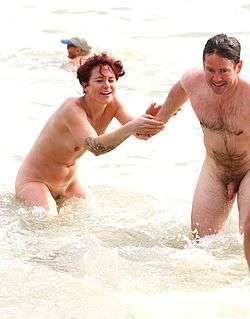
Nude swimming or skinny dipping is the practice of swimming naked, originally in natural bodies of water, but more recently in swimming pools or hot tubs. The widespread social convention and practice today is for swimmers especially in public places to wear a swimsuit. Most countries do not have specific laws proscribing nude swimming, and the matter is regulated largely by social convention and practice. Most nude swimming today takes place on nude beaches, or at naturist facilities, segregated public swimming areas or in private swimming pools. Some countries around the world regard nude swimming as public nudity, which is treated in a variety of ways, ranging from tolerance to strict enforcement of prohibitions against it.
The term skinny-dip was first recorded in English in 1947[1] and is most commonly used in the United States.
History
Georgian period
Thomas Guidott set up practice in the English town of Bath in 1668. He became interested in the curative properties of the waters and he wrote A discourse of Bathe, and the hot waters there. Also, Some Enquiries into the Nature of the water in 1676. This brought the health-giving properties of the hot mineral waters to the attention of the aristocracy.[2] Doctors and quacks set up further spa towns such as Harrogate, Bath, Matlock and Buxton soon after taking advantage of mineral water from chalybeate springs.[3] Here cures were guaranteed by 'taking the water' or being 'dipped' by bathing attendant in cold water. Treatment was received in the nude. Until the 1670s nude female bathing in the spas was the norm and only after that restrictions were imposed. As time progressed the resorts had to address two questions; was it right that men and women bathed together, and was it right that clothes should be worn. Establishments sought to impose dress codes.
Each town was free to make its own laws, and some chose to. For example, the Bath Corporation official bathing dress code of 1737 prohibited men and women to swim nude either in the day or in the night. Bath's specific rules were prescribed as follows:
It is Ordered Established and Decreed by this Corporation that no Male person above the age of ten years shall at any time hereafter go into any Bath or Baths within this City by day or by night without a Pair of Drawers and a Waistcoat on their bodies. No Female person shall at any time hereafter go into a Bath or Baths within this City by day or by night without a decent Shift on their bodies.[4]
Female bathing costumes were derived from those worn at Bath and other spas.
In the early 1730s, fashionable sea bathing initially followed the inland health seeking tradition. At English resorts such as Scarborough and Whitby, natural springs emerged from the cliffs allowing fresh water to be ingested and cold dip in the sea.[5] The resorts modelled themselves on Bath, and provided promenades, circulating libraries and assembly rooms.[6]
While sea bathing or dipping, men and boys were naked. Women and girls were encouraged to dip wearing loose clothing. Scarborough was the first resort to provide bathing machines for changing. Some men extended this to swimming in the sea and by 1736 it was seen at Brighton and Margate, and later at Deal Eastbourne and Portsmouth, [5] Seeing them frolicking in the sea attracted sightseers to the sea spa resort.
Working people also started to visit the coast to be dipped or bathe. In 1709, Walton records a man from Crosby having his daughters dipped in the sea to cure a skin complaint.[6]
For the common folk, splashing in rivers and swimming was a leisure activity and always done naked by boys and men and often by the women and girls. Bathing in the sea by the lower classes was noted in Southampton by Thomas Gray in 1764, and in Exmouth by shoals of Exeter damsels in unsufferable undress in 1779.[7] Lancashire working people bathed naked in the sea without any segregation in 1795:
lower classes of people of both sexes made an annual pilgrimage to Liverpool where they dabbled in the salt water for hours at each tide in promiscuous numbers and not much embarrassing themselves about appearance.[7]
Victorian period
At the beginning of the Victorian period, working people of both sexes bathed for pleasure without clothes. The genteel classes were bathing for health from using bathing machines, the men and boys swam naked while the girls and women dipped alongside them. [8] Near the University of Oxford an area for male nude bathing was known as Parson's Pleasure.
The rise of the influence of Christian Evangelicals caused arrangements for mixed bathing to be reassessed. Moral pressures forced some town councils to establish zones for the women and men to bathe separately. A half-hearted attempt was made to suggest to men that torso-suits would be fashionable, but this was resisted by genteel swimmers who believed that torso-suits restricted the contact between the skin and the saltwater.[8]
These areas were not policed, and around 1860–75,[9] under pressure from the church ever stricter byelaws were passed but not enforced. Mixed bathing was a popular activity for families, who would take their custom to the next resort along the coast if mixed bathing was imposed.[10] Resorts were trying to placate the Evangelicals without upsetting traditional bathers by designating separate areas of the beach.[11]
Drawers, or caleçons as they were called, came into use in the 1860s. Even then there were many who protested against them and wanted to remain in the nude. Rev. Francis Kilvert, an English nude swimmer, quoted by Cinder described men's bathing suits coming into use in the 1870s as "a pair of very short red and white striped drawers". Excerpts from Kilvert's diary show the transition in the England of the 1870s from an acceptance of nude bathing to the acceptance of bathing suits. Kilvert describes
a delicious feeling of freedom in stripping in the open air and running down naked to the sea.[12]
There are very few records of magistrates enforcing the bylaws. In 1895 Cosmopolitan reported that:
At most English resorts, buff bathing is available before eight o'clock in the morning. [13]
while Brighton, Worthing, Hastings, Bexhill, Bognor and Folkestone still tolerated nude bathing at any time of the day, in areas away from the central bathing areas.[13]
In 1895, The Daily Telegraph, Standard, Daily Graphic and Daily Mail newspapers ran a campaign to reintroduce mixed bathing in all resorts, pointing out that its prohibition split up families and encouraged them to take their holidays abroad. Commercial pressure defeated the moral pressures. Sea bathing had ceased to be done for health reasons, and was done overwhelmingly for pleasure. As the segregated beaches in town disappeared, bathing costumes for men became part of the commercial package, and nude bathing ceased.[14] Nude bathing continued to be practised outside resorts on isolated pieces of coast; a very few of these known beaches and coves later got local authority recognition as nude beaches.
The introduction of mixed bathing throughout Europe and elsewhere certainly created pressure towards bathing costumes being worn by both genders. However, well into the latter days of the Victorian Era, whereas all females were routinely wearing modest bathing attire, many boys well into their teens in Victorian England, even when in a mixed gender setting, were still swimming and playing at the beach resorts completely naked. An article published on August 23, 1891 in the Syracuse Sunday Herald suggests naked boys of up to 15 years in age were problematic for American parents with daughters, and read:
A 'Bewildered American' writes to the London Standard that he can't take his little girl to play in the sand at a British seaside resort without her being surrounded by crowds of naked boys. An English friend told him that they let their daughters play with naked boys of ten years of age, but draw the line at fifteen.[15]
All this was very much an English problem and one of attitude. In France discreet nude bathing for both sexes remained acceptable anywhere along the coast or on river banks apart from those in the town or village centres. In Germany, provision for nude swimming is made in major city centre parks such as the English Garden in Munich.
South Africa
Swimming was not only a sport for the residents of Victorian East London, Eastern Cape, but due to periodic water shortages, sometimes a necessity. From 1873 the town council promulgated measures to control swimming hours, apparel and especially separate swimming areas for men and women. These regulations were too conservative and constraining for the taste of the residents of this coastal town and for several decades they were the subject of legal battles, or were simply ignored. The dispute was finally settled in 1906 when mixed bathing was permitted with the proviso that both men and women should wear suitable swimming costumes.[16]
American experiences
Among notable Americans, Benjamin Franklin, an avid swimmer, possessed a copy of The Art of Swimming by Melchisédech Thévenot, which featured illustrations of nude swimmers.[17] American president John Quincy Adams was known to skinny-dip.

During the century, the woman's two-piece suit became common — a gown from shoulder to knees plus a set of trousers with leggings to the ankles. In the Victorian era, popular beach resorts were commonly equipped with bathing machines designed to avoid the exposure of people in swimsuits, especially to people of the opposite sex.
Skinny dipping by boys was common. The Dixon, Illinois Evening Telegraph published a request: "for boys swimming in the mill race to be more modest as women felt they can't go down Water Street for fear of seeing them."[18] In a 1909 New York elementary schools competition, boys in the 80 lb division competed naked; their bathing suits slowed them down.[19]
20th century
American president Theodore Roosevelt describes nude swims in the Potomac with his "tennis cabinet" in his Autobiography: "If we swam the Potomac, we usually took off our clothes.[20]
Ernest Thompson Seton describes skinny dipping as one of the first activities of his Woodcraft Indians, a forerunner of the Scout movement, in 1902.[21]
Indoor pools
The Young Men's Christian Association (YMCA) was set up in 1842 with a mission to provide an education programme and healthy sports to young men. The YMCA was responsible for providing swimming classes to countless numbers of American boys and teenagers. This included swimming in indoor pools. Swimming trunks were not permitted in their pools.[22] In Lincoln, Nebraska in 1958, for example, learners were told just to bring a towel and not to bring trunks. In Sheboygan, Wisconsin in 1954, the Recreation Department reported that 404 youngsters had attended an 11-day swimming course where the boys were unhampered by bathing suits.[23] When the YMCA began to admit females in the early 1960s, the wearing of bathing suits became a requirement.
In Portland, Ohio in 1915, all boys and girls wore torso swimming costumes and the pool was drained every 10 days. The problem was that woollen bathing suits were unhealthy and harboured the cholera bacteria and typhus bacteria which infected the water in the pool. Both the cholera and the typhus diseases could be fatal. As a precaution, the pool was completely drained every 10 days. In 1910, Sand filtration was introduced which reduced the number of bacteria present, but the safest way was not to wear woollen suits, and this approach was endorsed by the American Public Health Association (APHA). American high school and junior high school swimming in many states had policies that followed APHA guidelines. The guideline were published every three years, and from 1926 until 1962 every edition recommended nude swimming. In other states, all boys and girls bathed in clothes. The 1937 Administration of Health and Physical Recreation training manual stated:
- Nude bathing for boys is practiced universally, in a few schools girls may swim nude and this is the most sanitary method.
Nude female swimming was not allowed in most schools, both for modesty reasons and because it would be awkward to accommodate menstruating girls. The Detroit public schools briefly allowed nude female swimming in 1947; this policy was revoked after three weeks due to protests from parents.
Although chlorination was effective, it was difficult to manage the pH of the water, as chlorine could cause burning of the skin if wrongly administered. A simple test was devised in 1939 which made chlorination practical. World War II delayed its introduction until the early 1950s. The October 16, 1950 Life magazine had a large illustration of boys swimming together in the indoor pool of New Trier High School in Winnetka, Illinois, and the caption didn't mention they were naked.[24] The practice continued in the states that had a tradition of nude swimming.
During the 1960s, as baby boomers were entering high school, there was a growing backlash against enforced nude male swimming and by the 1970s, it had largely been phased out along with gender integration of pools. Male students protested the double standard of being required to go nude due to wool lint from swimwear clogging pool filters when it did not appear to cause a problem with girls' swim costumes. In any case, rising living standards post-WWII created a greater desire for privacy.
In some English schools, Manchester Grammar School for example, nude swimming was compulsory until the 1970s. It was discontinued when it started admitting girls.[25] This was also the case for some American high schools.[26] and junior high schools and in some summer camps. John Torney in his 1937 article on Swimming and Lifesaving programs for summer camps wrote that boys and girls enjoy the thrill of swimming nude and costumes can be discarded for a night swim.[27] A 2006 Roper poll showed that 25% of all American adults had been skinny dipping at least once, and that 74% believed nude swimming should be tolerated at accepted locations.[28]
Outdoors
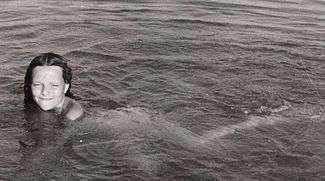
In the United States, states, counties and municipalities may enact their own dress codes, and many have. According to an Australian magazine, "In the early 1900s, women were expected to wear cumbersome dress and pantaloon combinations when swimming. In 1907, at the height of her popularity, Annette Kellerman was arrested on Revere Beach, Massachusetts, for indecency – she was wearing one of her fitted one-piece costumes."[29] In 1919, Ethelda Bleibtrey was arrested for nude swimming at the beach of Manhattan—she removed her stockings at a pool where it was forbidden to bare "the lower female extremities for public bathing". The subsequent public support for Bleibtrey led to the abandonment of stockings as a conventional element in women’s swimwear.
The 1912 Summer Olympics in Stockholm, Sweden were the first Olympic Games to feature female swimming as an event and the costumes used, which became translucent when wet, caused somewhat of a scandal. The United States protested that the event was "obscene" and refused to send a female swim team to the Olympics. Eventually an American women's swim team participated in the 1920 Summer Olympics in Antwerp, Belgium.
Nude swimming is fairly common in rural areas, where unexpected visitors are less likely. However, in some places even that type of swimming is prohibited by law. There is no federal law against nudity. Nude beaches, such as Baker Beach in San Francisco, operate within federal park lands in California. However, under a provision called concurrent jurisdiction, federal park rangers may enforce state and local laws, or invite local authorities to do so. Today, many swimmers in the United States confine nude swimming to private situations due to concerns about attitudes to public nudity.
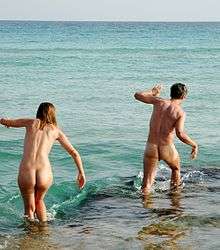
Naturist movement
Since the early 20th century, the naturist movement has developed in western countries that seeks a return to non-sexual nakedness when swimming and during other appropriate activities.[30] In some places around the world, nude beaches have been set aside for people who choose to engage in normal beach activities in the nude.
Contemporary status
Today, most nude swimming takes place at nude beaches, naturist facilities, private swimming pools, or secluded or segregated public swimming areas. Some Western countries, such as Canada and the United Kingdom, have no laws prohibiting nude swimming in public areas, but some countries around the world strictly enforce various laws against public nudity, including nude swimming. Some jurisdictions which maintain laws against public nudity may turn a blind eye to incidents of skinny dipping depending on the circumstances, as police officers on the spot decline to make arrests.[31]
Conflicts have arisen in the United States on federally-designated beaches, which are nevertheless patrolled by local police, since there is no federal law against nudity in these areas, but there may well be local ones. Skinny-dippers generally deal with this by keeping an eye out for local patrols, who generally do not go out of their way to find violators, as long as it is not flagrant.
In popular culture
Art
Nude swimming was a common subject of Old Masters – painters from before the 1800s – and Romantic oil paintings, usually bucolic or in a mythological or historical settings. For example, Swedish painters Georg Pauli and Anders Zorn painted a number of nude swimming scenes. In later periods, depictions of nude swimming scenes became rarer, but more likely to depict straightforward contemporary scenes. The cover of the August 19, 1911 edition of the Saturday Evening Post had a Leyendecker painting of three boys; the cover of the June 4, 1921 edition had Norman Rockwell's painting No Swimming, depicting boys in various states of undress escaping from the local authorities.
 Thomas Eakins, The Swimming Hole (1885)
Thomas Eakins, The Swimming Hole (1885)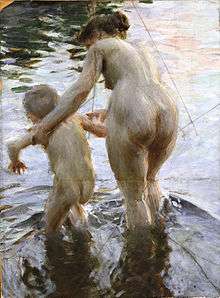 Anders Zorn, Une première - A mother teaching her child to swim (1888)
Anders Zorn, Une première - A mother teaching her child to swim (1888)%2C_Ruby%2C_gold_and_malachite%2C_1902.jpg)
 Saturday Evening Post 19 August 1911
Saturday Evening Post 19 August 1911 Eugene de Blaas, In the Water (1914)
Eugene de Blaas, In the Water (1914).jpg) Paul Gustave Fischer, A Morning Dip (1916)
Paul Gustave Fischer, A Morning Dip (1916) Saturday Evening Post 6-4-1921
Saturday Evening Post 6-4-1921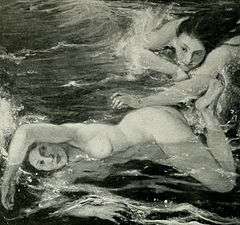 Charles Shannon, The Pursuit - Nudes Swimming (1922)
Charles Shannon, The Pursuit - Nudes Swimming (1922)
Films
A number of films have become notable in whole or in part due to their nude swimming scenes.
- 1918 – Tad's Swimming Hole, was a 1918 silent comedy film by King Vidor, it had frontal shots of nude boys that were censored in some places e.g. Chicago.
- 1933 – The film Ecstasy was banned in many places and censored in others. The film included a nude swimming scene with Hedy Lamarr.
- 1934 – Tarzan and His Mate featured the female lead (played by a double) swimming nude. However, religious groups lobbied to have the scene removed. Three versions of this movie now exist.
- 1943 – Child Bride featured the female lead, 12-year-old Shirley Mills, swimming nude. It is considered the most notable scene on the film.
- 1962 – In Marilyn Monroe's last ever film Something's Got to Give, Ellen Arden (Marilyn Monroe), swims nude at night in a swimming pool.
- 1971 – Walkabout, an Australian/British film directed by Nicolas Roeg, shows actress Jenny Agutter and actors David Gulpilil and Luc Roeg swimming nude. The nude swimming scenes are set in several water holes in the Australian outback, during an extended time disconnected from civilization.
- 1975 – In Jaws, the character Chrissie Watkins, played by Susan Backlinie, goes skinny dipping in the ocean and then gets attacked and killed by the shark. Susan Backlinie later reprised the scene in a self-parody in the comedy 1941 (1979), where she is snagged up by the periscope of a surfacing Japanese submarine.
- 1994 – Sirens, an Australian/British film directed by John Duigan, shows actresses Elle Macpherson, Portia De Rossi, Tara Fitzgerald and Kate Fischer swimming nude. The nude swimming is set in an artist's country property in the Blue Mountains in Australia and highlights the clash of sensibilities held by the main characters.
- 1997 - Dante's Peak, a disaster film, two young lovers go swimming naked in a volcanic thermal spring, only to find that it is reaching boiling point and they are boiled alive.
- 2007 – Wild Hogs, a comedy outlaw biker film, featured a scene where William H. Macy's character jumps nude into a pond and then convinces his friends – played by John Travolta, Tim Allen and Martin Lawrence – to join him. Shortly they are joined by a gay cop (John C. McGinley) who earlier had his sights on the four men, who quickly leave once they realize the cop's intentions.
- 2012 - 2 Headed Shark Attack, three characters (portrayed by Chase Conner, Anna Jackson and Amber English) go skinny dipping when skipping class and they are attacked by a two headed shark.
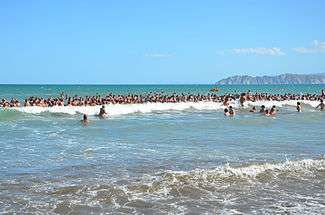
Television
- 2009 – Eve Kelly hosted The Skinny Dip, a Canadian travel show that sought out the world's most out-of-the-way swimming holes.[32]
World record
- 2013 – The current world record for the most people naked swimming is held by BW Summer Festival and The Edge. The official figure is 744 people and was achieved on December 31, 2013 at Midway Beach, Gisborne, New Zealand. The annual Skinny Dip World Record attempt is part of BW Summer Festivals annual events program.[33]
See also
References
Notes
- ↑ "skinny dip". Oxford English Dictionary (1st ed.). Oxford University Press. 1933.
- ↑ Burns 1981.
- ↑ Travis 1997, p. 8.
- ↑ Byrd 1987, p. 50.
- 1 2 Travis 1997, p. 12.
- 1 2 Travis 1997, p. 9.
- 1 2 Travis 1997, p. 11.
- 1 2 Travis 1997, p. 30.
- ↑ Travis 1997, p. 19.
- ↑ Travis 1997, p. 21.
- ↑ Travis 1997, p. 22.
- ↑ Cinder 1998, pp. 331-3.
- 1 2 Travis 1997, p. 23.
- ↑ Travis 1997, pp. 23,29.
- ↑ The Sunday Herald August 23, 1891.
- ↑ Tankard 1992.
- ↑ Thévenot 1789.
- ↑ Dixon, Illinois Evening Telegraph, 18 June 1890
- ↑ New York Times 1909.
- ↑ Roosevelt 2014, p. 53.
- ↑ Seton 1951, p. 297.
- ↑ Tate 2001.
- ↑ Jarvis 1954.
- ↑ LIFE. Time Inc. 16 October 1950. pp. 106–. ISSN 0024-3019.
- ↑ Cohen 2005.
- ↑ NPR 2006.
- ↑ Torney 1937.
- ↑ Roper poll online, Naturist education, 2006.
- ↑ "Herstory: Annette Kellerman", The Dawn (54), March 2004, archived from the original on 2005-11-18, retrieved 2010-09-27
- ↑ British Naturism (BN), ISSN 0264-0406, archived from the original on 2012-03-31, retrieved 2011-08-30
- ↑ Goodman 2013.
- ↑ CBC.ca 2009.
- ↑ "Largest skinny dipping (swimming naked)". Guinness World Records. Retrieved 2014-08-15.
Bibliography
- Monographs
- Cinder, Cec (1998). The Nudist Idea. Riverside, California: Ultraviolet Press. ISBN 978-0-9652085-0-5.
- Roosevelt, Theodore (2014). Theodore Roosevelt: An Autobiography. Floating Press. ISBN 978-1-77653-337-4.
- Seton, Ernest Thompson (1951). Trail of an Artist Naturalist. London: Hodder and Stoughton. p. 297. ISBN 0-405-10734-X.
- Thévenot, Melchisédec (1789). The Art of Swimming: Illustrated by Forty Proper Copper-plate Cuts, ... With Advice for Bathing. By Monsieur Thevenot. Done Out of French. To which is Prefixed a Prefatory Discourse Concerning Artificial Swimming, ... (Third ed.). London: John Lever.
- Travis, John (1997). "Sea-bathing from 1730 to 1900". In Fisher, Stephen. Recreation and the Sea. Exeter: University of Exeter Press. ISBN 978-0859895408.
- Journal articles
- Byrde, Penelope (1987). "'That Frightful Unbecoming Dress' Clothes for Spa Bathing at Bath". Costume. 21 (1): 44–56. doi:10.1179/cos.1987.21.1.44. ISSN 0590-8876.
- Burns, D. Thorburn (1981). "Thomas Guidott (1638–1705): Physician and Chymist, contributor to the analysis of mineral waters". Analytical Proceedings including Analytical Communications: Royal Society of Chemistry. 18 (1): 2–6. doi:10.1039/AP9811800002. Retrieved 10 December 2007.
- Tankard, Keith (1992). "Bathing habits in Victorian East London." (pdf). Contree (32). Retrieved 2014-08-15.
- Torney, John A. (1937). "Swimming and Lifesaving program for summer camps". Journal of Health and Physical Education. University of Washington. 8 (6): 360–392. doi:10.1080/23267240.1937.10619786.
- Newspaper articles
- Cohen, Michael (December 2005), "Swimming Naked at MGS" (PDF), The Mancunian, Old Mancunians, archived from the original (PDF) on 2012-06-17, retrieved 2007-11-27
- Goodman, J. David (July 17, 2013). "Daring Enough to Bare It All for a New York Swim". New York Times. Retrieved 15 Aug 2014.
- "A "Bewildered American"". The Sunday Herald. Syracuse. August 23, 1891. p. 4 col B. Retrieved 15 Aug 2014.
- Naked in High School: Bad Dreams Do Come True, National Public Radio, Aug 1, 2006, retrieved 2007-11-27
- "N.L. skinny dipper hosts TV travelogue". The Canadian Press. Newfoundland and Labrador. Nov 9, 2009. Retrieved 15 Aug 2014.
- Jarvis, Mrs Richard J. (22 June 1954). "Recreation Department conducts eleven day swimming instruction court at Central H.S. pool". Sheboygan Press. p. 10 col E. Retrieved 2015-11-17 – via Newspaper Archive. (subscription required (help)).
boys swim unhampered by suits and only bring a towel
- "Young Swimmers in Championships". New York Times. 18 April 1909. p. 30 col C. Retrieved 2015-11-17 – via Newspaper Archive. (subscription required (help)).
- Online
- Tate, Cassandra (14 March 2001). "Young Men's Christian Association (YMCA) of Greater Seattle - Part 3: Readjustment, 1930-1980". historylink.org. Retrieved 2014-08-15.
Further reading
- Rew, Kate (2008). Wild Swim: River, Lake, Lido and Sea: The Best Places to Swim Outdoors in Britain. Guardian Books, London. ISBN 978-0-85265-093-6.
External links
| Wikimedia Commons has media related to Skinny dipping. |
- Nude Swimming at Johnston JHS, 1959 to 61
- Nude Male Swimming Historic Archives Extensive archive of past era skinny dipping including the YMCA and various public schools in the U.S. up to the late 1970s
- Guide to Swimming Holes and Hot Springs
- The Naturist Society
- South Florida Free Beaches (Haulover Beach Park)
- Naturist Education Foundation
- B.E.A.C.H.E.S. Foundation
- Crown Prosecution Service -Nudity in Public - Guidance on handling cases of Naturism (UK specific)